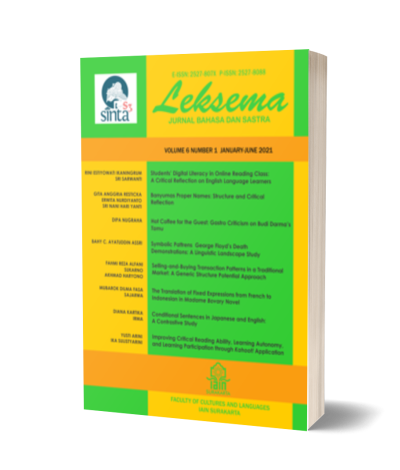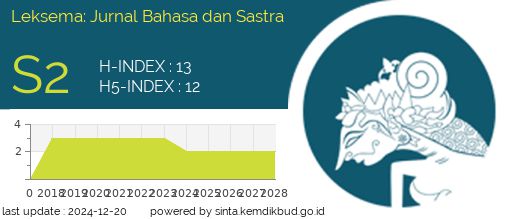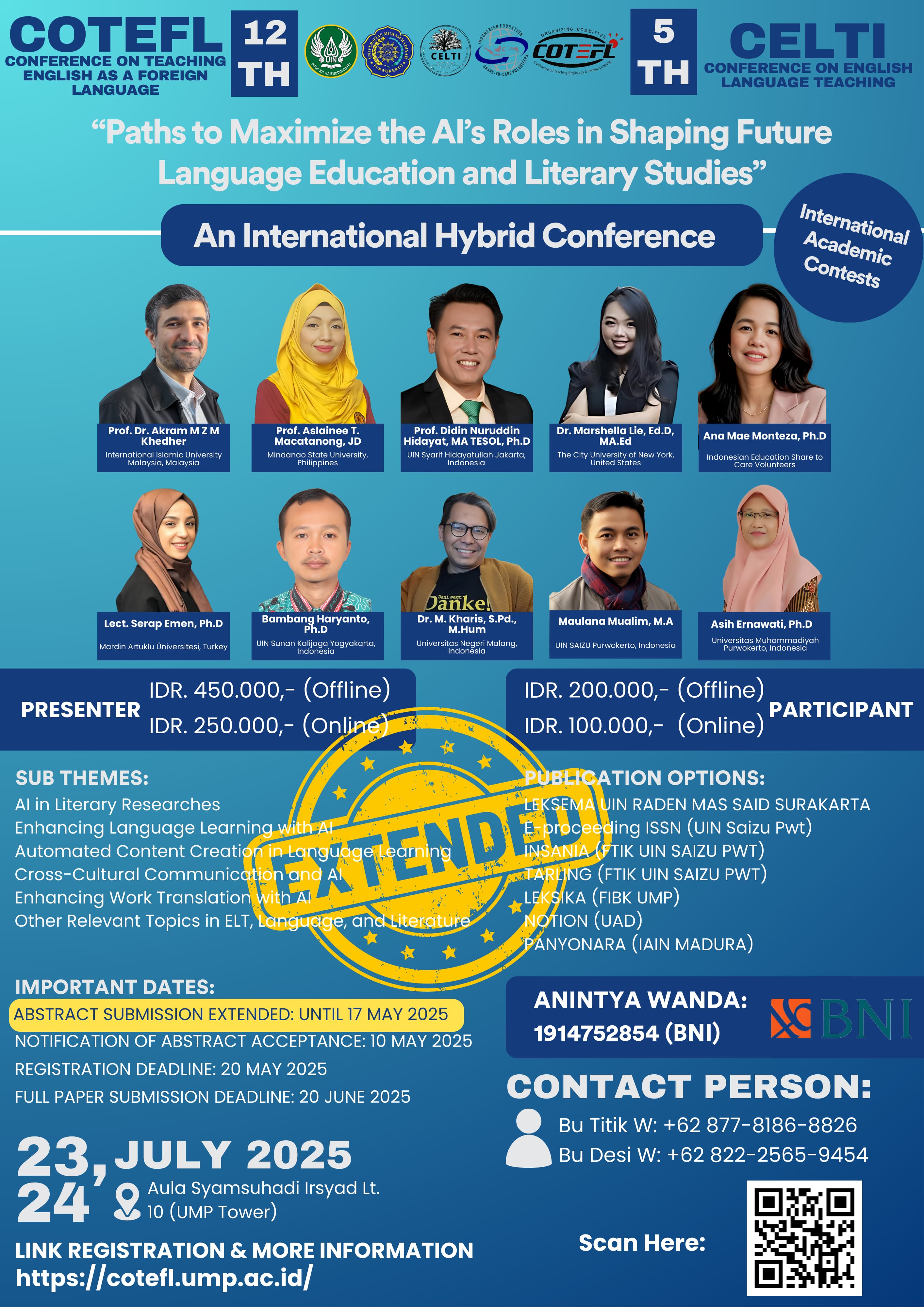SELF-ESTEEM COHESION AND RESILIENCE ABILITY OF A MARGINAL CHILD IN 'PÃœNKTCHEN UND ANTON' ROMAN (KOHESI SELF-ESTEEM DAN KEMAMPUAN RESILIENSI ANAK MARGINAL DALAM ROMAN 'PÃœNKTCHEN UND ANTON')
DOI:
https://doi.org/10.22515/ljbs.v4i2.1781Keywords:
Pünktchen und Anton, marginalized child, self-efficacy, self-esteem, self-respectAbstract
Germany nowadays is known as one of the most robust economies in Europe. Yet, at the beginning of 20th Century Germany, poverty became a severe problem that caused a social and cultural impact on the children. Positive self-esteem and resiliency in children were needed to cope with the situation. The roman titled Pünktchen und Anton, written in 1931 by Erich Kästner, describes the children’s life in Berlin dealt with the poverty problem. This research aims to see how self-esteem and resiliency in children described as a life tool for the first figure (Anton) who classified as an adversity child in the novel. This question is answered by using descriptive qualitative method and self-esteem theory by Nathaniel Branden. The result shows there is advocacy in describing a marginalized Anton to become a hero thank to his positive self-esteem (self-efficacy and self-respect). His positive self-esteem builts him to be resilient.Downloads
References
Ali, Nelly. 2011. “The Vulnerability and Resilience of Street Children.†Global Studies of Childhood, 1 (3): 260-264. <https://remotelib.ui.ac.id:2067/10.2304/gsch.2011.1.3.260>
Aptekar, Lewis. 1994. “Street Children in the Developing World: A Review of Their Condition.†Cross-Cultural Research 28 (3): 195-224. <https://doi.org/10.1177/106939719402800301>
Bentley-Taylor, Brenden. 2012. Searching for New Life: How Children Enter and Exit the Street in Indonesia (Master Thesis) University of Victoria. <https://dspace.library.uvic.ca/handle/1828/5958>
Benzies, Karen & Richelle Mychasiuk. 2009. “Fostering Family Resiliency: A Review of the Key Protective Factors.†Child & Family Social Work, 14, (1): 103-114. <https://doi.org/10.1111/j.1365-2206.2008.00586.x>
Bowlby, John. 1956. “The Growth of Independece in Young Child.†Royal Society of Health Journal, 76: 587-591. <https://doi.org/10.1177/146642405507600912>
Branden, Nathaniel. 1992. The Power of Self-Esteem. Deerfield Beach: Health Communications
Branden, Nathaniel. 1994. The Six Pillars of Self-Esteem. New York: Bantam
Branden, Nathaniel. 1997. Self-Esteem Everyday. New York: Simon & Schuster
Dayton, Tian. 2011. “Growing Up Rich: How it Shapes Identity,†The Huffington Post, November 17.
Deutsche Welle, 2007, January 5 “Street Children on the Rise in Germany, Aid Agency Warnsâ€. <https://p.dw.com/p/ 9ecp>
Eisele, Ines, 2019. “Germany’s Thousands of ‘Missing’ Refugee Minors,†Deutsche Welle, January 28. <https://p.dw.com/p/ 3CLB4>
Evans, Richard J. 2018. “A Community of Defeat,†The Nation, October 29.
Hindy, L. 2018. “Germany’s Syrian Refugee Integration Experiment.†The Century Foundation, September 10. <https://tcf.org/content/report/germanys-syrian-refugee-integration-experiment/?session=1>
Jindal-Snape, Divya & D. Miller. 2008. “A Challenge of Living? Understanding the Psycho-Social Process of the Child During Primary-Secondary Transition Through Resilience and Self-Esteem Theories.†Educational Psychology Review 20 (3): 217-236 <http://remote-lib.ui.ac.id:2093/stable/23363889>
Karatas, Zeynep, &Firdevs Savi Cakar. 2011. “Self-Esteem and Hopelessness, and Resiliency: An Exploratory Study of Adolescents in Turkey.†International Education Studies 4 (4). doi:10.5539/ies. v4n4p84
Miller, David & Brigid Daniel. 2007. “Competent to Cope, Worthy of Happiness?: How the Duality of Self-Esteem Can Inform a Resilience-Based Classroom Environment.†School Psychology International 28 (5): 605-622. doi:10.1177/0143034307085661
Moleong, Lexy J. 2010. Metodologi Penelitian Kualitatif. Bandung, Indonesia: Remaja Rosda Karya
Puteri, Fierda Octiara. 2015. “Nilai Pendidikan Karakter dalam Novel Sastra Anak Pünktchen und Anton Karya Erich Kästner.†Identitaet 4 (2): 1-5. http://jurnalmahasiswa.unesa.ac.id/ index.php/identitaet/article/view/12273.
Riyanda, Wahyu Dhyanita Abhisekha Puspa & Aloysius Soesilo. 2018. “Resiliensi Anak Tunggal yang Memiliki Orangtua Tunggal dengan Status Sosial Ekonomi Rendah.†Psycho Idea, 16 (1): 59-73. doi:10.30595/ psychoidea.v16i1.2498
Such, Elizabeth, & Robert Walker. 2004. “Being Responsible and Responsible Beings: Children Understanding of Responsibility.†Children & Society, 18, (3): 231-242. doi:10.1002/chi.795
UNICEF . 2001. A Study on Street Children in Zimbabwe. <https://www.unicef.org/ evaldatabase/index_14411.html>
West, Andrew. 2003. “At the Margins: Street Children in Asia and the Pacific.†Poverty and Social Development, 8: 1-66. <http://hdl.handle.net/11540/2287>
Wu, Yie-Len, Jian Chen, Lin-Shen Yang, Xiu-Xiu Ding, Hui-Yun Yang, & Ye-Huan Sun. 2015. “Change an Associated Factors of Self-Esteem among Children in Rural China: A Two-Year Longitudinal Study.†Psychology, Health & Medicine 20 (8): 879-888. doi:10. 1080/13548506.2014.983136
Downloads
Published
Issue
Section
License
The copyright of the received article shall be assigned to the publisher of the journal. The intended copyright includes the right to publish the article in various forms (including reprints). The journal maintains the publishing rights to published articles.
In line with the license, the authors and users (readers or other researchers) are allowed to share and adapt the material only for non-commercial purposes. In addition, the material must be given appropriate credit, provided with a link to the license, and indicated if changes were made. If authors remix, transform or build upon the material, authors must distribute their contributions under the same license as the original.






